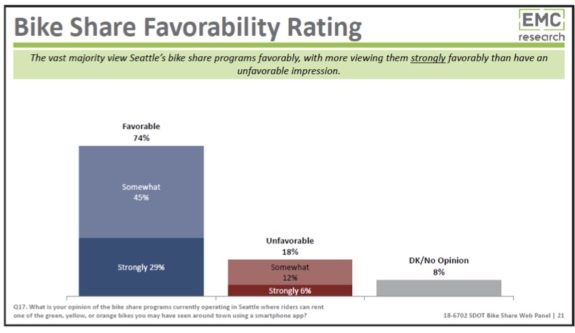
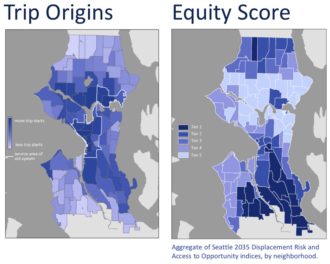
The $1 Spin, Lime and ofo bikes around Seattle are very popular, appeal to wide demographics and are very often used to access transit. These are some of the findings from Seattle’s bike share permit pilot, setting the stage for the creation of a permanent permit scheme in June that could go into effect by the end of July.
According to a (perhaps too*) positive survey by EMC Research (PDF), 74 percent of Seattle favors the bikes. Thirty percent strongly favors them while only six percent strongly dislikes them.
I would love to believe the results are accurate, but the more I ran the numbers, the more I suspected the survey sample over-represents bike share users. So while it is safe to say an impressive number of Seattleites ride bike share, I suspect the survey’s estimates are a bit high. So keep that in mind when you digest the results. See the footnote* below for more about the survey discrepancies.
“Regardless of their own interest in becoming bike share users,” according the EMC report, “Seattleites recognize the positive impacts to the broader community of having bike sharing (e.g. environmental benefits and reduced traffic), as well as the benefits to users themselves.”
But beyond just public opinion, the bikes are getting a lot of new people riding. Survey results estimate that one third of Seattle adults had already given them a try as of February when the survey was conducted. Another third said they were interested in trying them. If that figure is accurate*, that’s more than 196,000 Seattle adults riding bike share with another 196,000 potential adult users, and that doesn’t even count all the teenagers, tourists and regional riders who live outside the city limits. And that survey was taken before the introduction of e-assist bikes and the recent record-breaking numbers on the city’s bike counters, which include even more new bike share riders.
https://twitter.com/BlakeTrask/status/1002549868026400768
The bike share permit pilot has been an astounding success for Seattle, which has led the nation in redefining the role of bike share in a major city. 10,000 bikes are currently permitted in Seattle, and they have already changed the way many people in Seattle get around. The city should be proud of this achievement and looking for ways to build on it and continue to innovate.
Seventy-five percent of bike share users report using the bikes to access transit, further confirmation that bike share is a complement to transit service by closing the notoriously difficult “last mile” problem for transit services. Buses, trains and ferries are very good at getting a lot of people across the bulk of a metro area, but they are not great at getting people from door to door. Bike share is perfect for cutting down on long walks to the bus stop or for skipping a local bus connection by biking directly to an express route stop or station. Quite often, combing bike share and transit is the fastest way to get around. It’s also fun, healthy and environmentally friendly.
Undoubtedly, many trips have shifted away from personal and for-hire cars to bikes and transit. Seattle should be proud of this achievement and look for ways to keep building on this success to shift even more trips and invite even more transportation innovation.
Some demographic highlights from the survey as notes in an SDOT presentation to the City Council Transportation Committee:
- 62% Male, 38% Female
- Most users between 25-44
- 36% of Hispanic & African-American survey respondents have tried bike share
- 32% of Asian respondents have tried bike share
- 32% of White respondents have tried bike share
If accurate,* these figures are pretty remarkable. One of the big questions about dockless bike share was whether it could better reach a more diverse ridership than many of the nation’s station-based systems. And this survey suggests that race has little impact on whether someone will use one of the bikes. If anything, Hispanic and African American residents are slightly more likely to try one than white residents (though white residents are slightly more likely to use them often):
Also of note here: Residents of South and West Seattle were more likely to ride than residents of North Seattle. This makes the city’s ongoing lack of bike infrastructure investment in South and West Seattle even more egregious.
Diving deeper into the survey results, there is a generational divide around the bikes. Though all three adult age brackets like the bikes, the 55+ set was much less likely to use them and far more likely to view them unfavorably:
I am especially curious to see how the introduction of e-assist bikes will affect the generational divide. Anecdotally, I see many more seniors on the Lime-E bikes, which are easier on the joints and require less physical endurance to scale hills. I look forward to seeing if data confirms this observation.
Though the survey found that Seattle residents largely favor the bike share scheme, the vast majority (85 percent) of people who called or emailed SDOT staff about the bikes were unfavorable. And that makes sense. Of course people who are compelled to call the city are more likely to be upset about something. When is the last time you called city staff to tell them you really like something they did? Well, come to think of it, maybe you should do that sometime. It might make a city staffer’s day.
The biggest complaint is that bikes are parked in the way, and this concern is especially potent for people with mobility or vision impairments. A survey of bikes found that only four percent of bikes were parked in a way that fully impeded a pathway. 70 percent were parked correctly and the rest were technically parked improperly but were not causing a serious pathway blockage. But four percent of 10,000 bikes is still a significant number of walkway blockages. The city, companies and users need to work together to keep walkways clear.
SDOT has already tested a series of designated bike share parking spaces, basically just boxes painted on the sidewalk.
“We also see some capacity for this to be in the street, essentially looking like a bike parking corral SDOT already builds,” said SDOT Bike Share Program Manager Joel Miller during the presentation to the City Council Transportation Committee. And if they are positioned close to an intersection, they can also act as a crosswalk improvement by improving visibility and making the crossing distance shorter.
And though 76 percent of observed users were not wearing a helmet, an preliminary UW/Harborview study saw no increase in head injury risk from the bikes, according to the SDOT presentation. There were only five collisions involving people on bike share bikes that SDOT staff could find, and none resulted in serious injury.
One odd finding from the EMC survey: Only 37 percent of people know that the current bike share systems are funded by private companies. 27 percent think the city is funding it. More Seattleites need to read Seattle Bike Blog.
Going forward, the city will release the full bike share pilot report and present the updated permit to the Transportation Committee June 19, and that could pass full Council approval June 25. SDOT would then roll out the new permit by the end of July.
* The survey says 11 percent of Seattleites rode the bikes 11 times or more in the six months before taking the February survey. If that were true, that share of rides alone would be at the very least 742,000 rides (614,000 Seattle adults * .11 * 11) , well more than the 468,000 total rides counted during the nearly six months of the pilot (mid-July through December). That just doesn’t add up. The survey was a “recruit-only” web panel survey of 601 residents, and results were weighted to closely match Seattle’s demographics. It is more scientific than an opt-in web survey, and respondents did not know the survey topic before agreeing to participate. That said, researchers note that any web survey will underrepresent people who do not have good access to the Internet. EMC Research says that if the sample were representative, it would have a margin of error comparable to +/- 4 percent. But my back of the envelope math suggests the margin in this survey is quite a bit larger than that. It may be that people who take web panel surveys are more likely to be tech savvy and, therefore, more likely to take bike share than the general population. Or perhaps the survey takers overestimated how often they used them. Or perhaps the city’s trip counts are low. I have asked EMC about the discrepancy. You can read more about the methodology in the beginning of the report (PDF).
UPDATE: Ian Stewart from EMC confirms that this survey shouldn’t be used to extrapolate ridership numbers. Instead, people should think of it as a sampling of opinions about bike share from a set of residents mirroring (but not statistically representative of) city demographics. From Stewart:
While we made every effort to get a sample that looked representative and got a diverse set of respondents that demographically mirror the city, since not all Seattle residents have an equal probability of being selected for the survey, these numbers shouldn’t be used to extrapolate usership numbers. That would’ve required a different methodology, but given that SDOT has other sources of info on actual ridership that don’t rely on self-report, we were focused primarily on an approach that would get us good data on attitudes about the program (among both those who report not having used the program as well as those who say they have) within a set budget. Additionally, given that we used a non-probability sample, we also can’t strictly apply the classical margin of error; it is possible that since this is web, and smartphones are generally the way you get access to bikeshares, there could be a small bias in the sample towards that audience.
Furthermore, when it comes to usage and frequency numbers, people tend to overreport behaviors and not be 100% accurate when they’re recalling things like how many times they’ve done something in a set timeframe. So when comparing self-reports to actual ridership data, we’d expect numbers to be higher even if we’d used a methodology that captured a true probability sample.

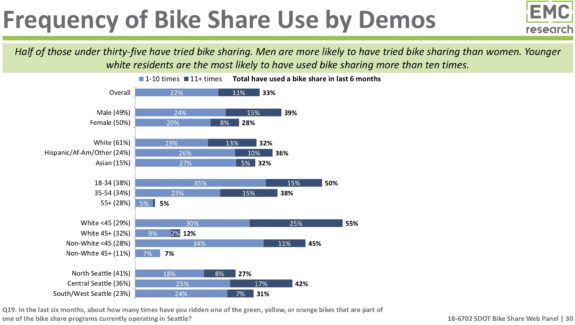
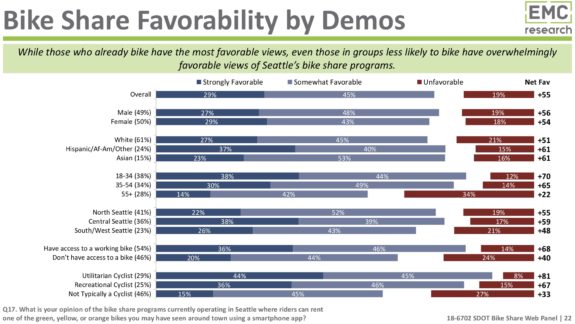
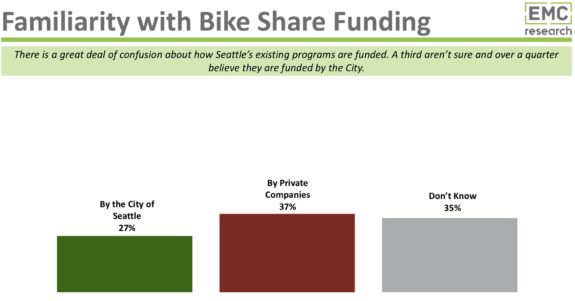











Comments
13 responses to “Survey: Ahead of bike share permit update, survey says Seattleites are very supportive”
I think your estimate of 614,000 adults who would use the system is too high. In King County in 2010, the population was between 18-55 (the demographic group using bikeshare the most) was 56% of the total population. The city estimates that the 2017 population was 713,000. If we assume the KingCo ratios in 2010 reflect Seattle demographics in 2017, that puts the estimate of the Seattle adult population between 18-55 at about 400,000. That would be about about 480,000 rides (400,000 * 0.11 * 11).
https://www.ofm.wa.gov/washington-data-research/population-demographics/population-estimates/estimates-april-1-population-age-sex-race-and-hispanic-origin
https://www.seattle.gov/opcd/population-and-demographics
Interesting that many people don’t know the bike shares are run by private companies. I think, considering the negative issues surrounding SDOT right now, it would behoove the city to put a favorable spin on this.
I’m going to keep saying this again and again because the anti-bike crowd won’t shut up about the fact that cycling as a primary commute mode has remained flat for years. We need to push for a new metric that captures the enormous increase in people biking thanks to bikeshare–even if its just part of a multi-modal trip. Whether or not it’s their primary mode of transit, they still deserve a safe and connected bike network around the city. The bus isn’t my primary mode of transit but I still care deeply about expanding the network and improving its efficiency. We need to change the narrative.
With respect to parking, I think the next step is to add some on street parking zones in neighborhoods that get a lot of bikeshare left there, but don’t have sidewalks wide enough for furniture zones. For the most part, people will park properly if you give them a place to do it, but they won’t do is circle around from block to block, looking for a furniture zones.
In my neighborhood, a couple of strategically placed bikeshare parking zones would make a big difference in reducing the number of bikes obstructing the sidewalk.
Did any of the other non-bike share stats that were broken out seem out of line with previous estimates? For example the 2% who use bicycles as primary mode of transportation and 13% who use bicycles “regularly” sound in line with ~3% mode share and I think I heard up to 13% bike to work at least once a week in summer (looks like 16% for that number on another question). At least the number of people who tried the system has an independent source of data that can be cross-referenced.
[…] Streets Blog USA, Seattle Transit Blog, and Seattle Bike Blog report that the dockless bike share pilot overall seems to be gaining […]
This is good news. It wasn’t clear after the demise of Pronto if bike share could survive Seattle, but it appears that it’s here to stay and growing.
The city, companies and users need to work together to keep walkways clear.
I disagree with this statement 100%. The for-profit bikeshare companies need to assume complete responsibility for where their bikes are parked and Seattle should hold them accountable. If the companies feel the need to pass responsibility and consequences on to their users, then so be it. It is not Seattle nor it’s residents (outside of users) responsibility to clean up after a for-profit company that is using public infrastructure to their benefit, no matter how useful a service they provide to the public.
In general, people will park bikes properly, when given a place, but where there is nowhere to park without getting in the way, people will park where it gets in the way.
I live on one such street, and the problem is entirely preventable – so much of the street is given over to parking cars that there’s not one inch of space left over to park a bicycle without blocking the sidewalk. If the city could paint in a couple of bike corrals in key locations – at intersections and next to staircases – the parking problem could be solved almost overnight. In many cases, they wouldn’t even need to sacrifice any car parking, since the street sections next to intersections are usually no parking anyway.
Traditionally, on-street bike parking was seen as only necessary in commercial areas, not residential, because people want to store their bikes at home in a secure garage, not out on the street. Bikesharing has completely upended this assumption. In order for the system to be usable, people need to be able to pick up and drop off bikes where they live. But, they also need to park the bikes somewhere that’s publicly accessible for the next user to ride them. You can’t just tell people to park in a furniture zone and expect people to walk half a mile out of their way to the nearest furniture zone.
Since the city owns the streets, this is where the city’s role comes into play. I’m not opposed to the city requiring the companies to pay for the cost of painting in the on-street parking zones, nor am I proposing that it would be cost-effective to do in every single block of single-family housing. I’m saying start with the residential areas with lots of multi-family housing, and where bikes (and parking complaints) are tending to accumulate, and work from there.
Another role the city has to play would be to make it easier for people to move bikes that are illegally parked. In many cases, it is easier to open up the app and move a bike than it is to complain about the parking and wait hours or days for a company staff person to come in and move it. But, the way the system is currently set up, moving an illegally parked bike yourself requires either lifting the weight of the bike (very heavy for the e-bikes), or paying $1 to unlock it. The notion of having to pay to move a bike out of the way that somebody else decided to park in your driveway is ridiculous. The city should require a grace period, so that all trips under one minute are free. This way, you can unlock illegally parked bikes without having to pay (and also switch out a broken bike for a working bike, without having to pay twice).
I live on one such street, and the problem is entirely preventable – so much of the street is given over to parking cars that there’s not one inch of space left over to park a bicycle without blocking the sidewalk.
Your point is valid, however when faced with this choice, some people are leaving them in the middle of the sidewalk, not to the side, which while still annoying, is better than blocking the sidewalk. This is very evident on the sidewalk adjacent to the Westlake cycle track. The percentage is very low, granted, but the obnoxiousness/annoyance is extremely high.
Another role the city has to play would be to make it easier for people to move bikes that are illegally parked. In many cases, it is easier to open up the app and move a bike than it is to complain about the parking and wait hours or days for a company staff person to come in and move it.
If people want to make the effort to move it, they can and should be able to do it. But again, these are for-profit companies. We the people should not be responsible for cleaning up after their ignorant user’s anti-social behavior. The City should, and probably will, adopt part of Bellevue’s regulation where the company has X amount of time during the day (2 hours I think?) or Y amount of time during the night (something like 10 hours or by 7 AM) to move an improperly parked bike or face a fine.
I get the point, and they probably should do that also. But in many cases, it is simply less effort to move the bike yourself than to fiddle with the app to request the company to do it. Plus, you don’t have to wait.
The trip origin map is one more example of why south seattle needs a north/south protected bike lane.
One issue I wish that the survey would have covered was equity of access. While it’s great that there are more bikes on the street and that ridership is higher than that of pronto, in order to ride one of these bikes people must have a credit card, a smart phone and a data plan. Maybe that was ignored because this was an online survey, but if the city wants to be serious about making sure that everyone has access to the bike share program then there should be at least some conversation on how to still provide easy access.
Personally, I wish that the private companies were required to somehow take orca cards – that would be easy for everyone who rides transit and it would make the bikes act as part of the existing transit system.
I believe it is technically possible for an unbanked user to use the service. It requires an ugly mixture of physically visiting the office to deposit money and waiting on hold for customer service to remotely unlock the bikes. I don’t know if anybody actually does this, but the point is that we can pat ourselves on the back and say it’s possible.
Some relevant news today: https://twitter.com/seabikeblog/status/1005116577325314048?s=21